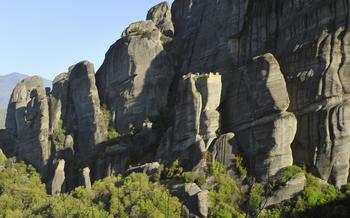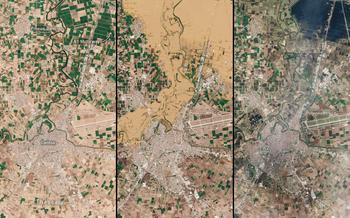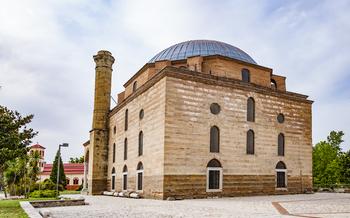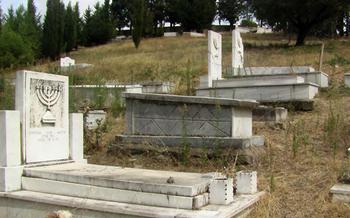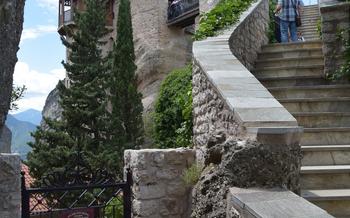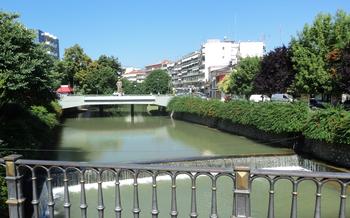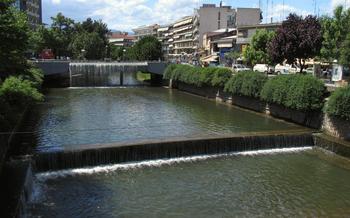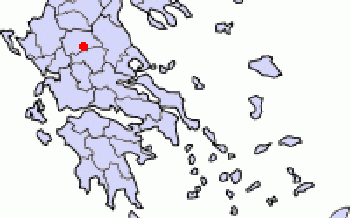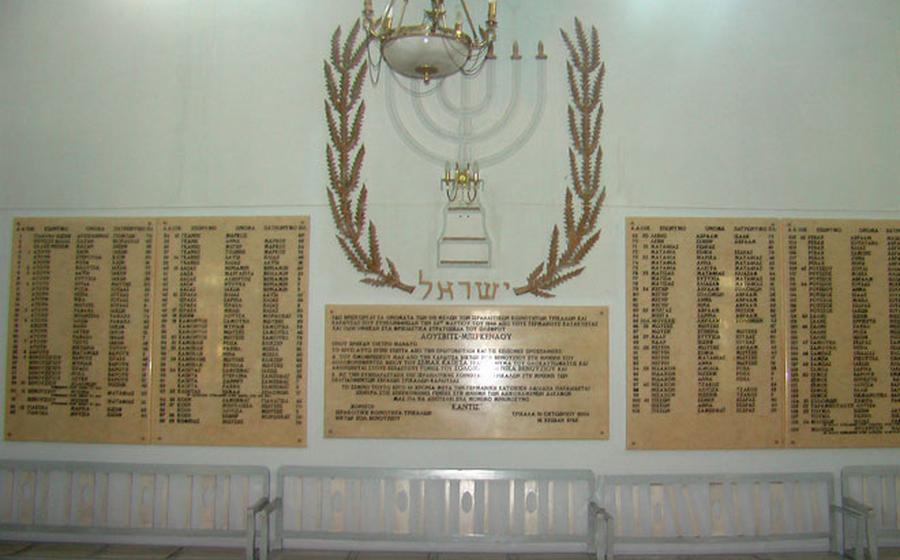
Meteora Hiking Trails
- Historical Background
- Natural Beauty
- Hiking Trails
- Great Meteora Monastery
- Varlaam Monastery
- Rousanou Monastery
- St. Stephen's Monastery: A Journey Through Time
- Ypapanti Monastery
- Hiking Tips
- Best Time to Visit
- Getting There
- Accommodation
- Food and Drink
- Other Activities
- Insider Tip
Historical Background
Meteora's history is intertwined with the rise of Eastern Orthodox monasticism and the search for spiritual solitude. In the 10th century, hermits seeking refuge from worldly distractions began to inhabit the caves and crevices of the imposing rock formations. Over time, these hermits established small monastic communities, laying the foundation for the Meteora monasteries we see today.
The monasteries reached their peak during the 14th and 15th centuries when they became a refuge for monks fleeing the Ottoman conquest of Constantinople. The monks constructed elaborate monasteries atop the rock pillars, using innovative engineering techniques and materials available. These monasteries not only provided a safe haven for the monks but also became centers of religious and cultural life in the region.
Natural Beauty
Meteora's natural beauty is as captivating as its historical significance. The towering rock formations, sculpted by centuries of wind and erosion, create a breathtaking landscape that is unlike anything you've ever seen. The monolithic pillars rise majestically from the ground, forming a unique geological wonder that has to be seen to be believed.
As you hike through the Meteora trails, you'll be treated to stunning panoramic views of the surrounding countryside. The lush forests, meandering rivers, and distant mountain ranges create a picturesque backdrop for your adventure. The diverse flora and fauna add to the region's natural charm, with wildflowers blooming in spring, and birds of prey soaring overhead.
Whether you're an experienced hiker or a nature enthusiast, Meteora has something to offer everyone. The natural beauty of the region is a true testament to the power of nature, and it's sure to leave you with lasting memories.
Hiking Trails
Meteora's breathtaking landscape is best experienced on foot. An extensive network of well-marked trails winds through the forests and along the cliffs, offering varying difficulty levels and scenic routes. Whether you're an experienced hiker or a casual walker, there's a trail to suit your abilities and preferences.
One of the most popular trails leads to the Great Meteora Monastery, the largest and most famous monastery in Meteora. The trail winds through a dense forest, passing by several smaller monasteries and hermitages along the way. The views from the top are simply stunning, with the monasteries perched precariously on their rocky outcrops.
Another popular trail leads to the Varlaam Monastery, the second-largest monastery in Meteora. This trail is slightly more challenging, with some steep sections and loose rocks. However, the rewards are worth the effort, as the Varlaam Monastery offers stunning views of the surrounding landscape.
For those looking for a more challenging hike, the trail to the Rousanou Monastery is a good option. This trail is steep and rocky, but the views from the top are unparalleled. The Rousanou Monastery is built on a narrow ridge, and the views from the monastery's windows are simply breathtaking.
No matter which trail you choose, be sure to wear proper footwear and clothing, and carry water and snacks. Also, be respectful of the monasteries' dress code, and be aware of the weather conditions before you start your hike.
Great Meteora Monastery
The Great Meteora Monastery stands as the largest and most renowned monastery complex in the Meteora region. Perched atop a monolithic rock formation, it offers a breathtaking spectacle that leaves visitors in awe. Its strategic location provides unparalleled views of the surrounding landscape, making it a true gem among the monasteries.
Founded in the 14th century, the Great Meteora Monastery is an architectural marvel that has withstood the test of time. Its intricate frescoes and iconography, meticulously preserved over the centuries, transport visitors to a bygone era. The monastery's collection of Byzantine art, including priceless icons and manuscripts, is a testament to its rich history and cultural significance.
As you embark on a journey to the Great Meteora Monastery, be prepared to be captivated by its mystical aura. Whether you're a history buff, an art enthusiast, or simply a traveler seeking tranquility, this iconic monastery promises an unforgettable experience.
Varlaam Monastery
The second-largest monastery in Meteora, the Varlaam Monastery is a testament to the architectural prowess of the monks who built it. Perched atop a towering rock, the monastery offers breathtaking views of the surrounding landscape. Its impressive frescoes and icons, depicting scenes from the Bible and the lives of the saints, are a testament to the artistic talents of the monks who once called this place home. Visitors can explore the monastery's various chapels and admire the intricate carvings and decorations that adorn its walls. The monastery also houses a small museum, where visitors can learn more about the history and significance of Varlaam Monastery.
Rousanou Monastery
Perched atop a narrow ridge, Rousanou Monastery is a picturesque sight that draws visitors with its unique charm. Founded in the 16th century, this monastery is known for its well-preserved frescoes and murals that depict scenes from the Bible and the lives of saints. The interior of the monastery is adorned with intricate carvings and colorful paintings, creating a serene and awe-inspiring atmosphere.
One of the highlights of Rousanou Monastery is its peaceful atmosphere. Situated away from the crowds, this monastery offers a tranquil retreat where visitors can escape the hustle and bustle of everyday life. The surrounding nature adds to the serenity, with stunning views of the surrounding landscape and the distant mountains.
Visitors to Rousanou Monastery can explore the various chapels and admire the beautiful icons that adorn the walls. There is also a small museum within the monastery that showcases religious artifacts and provides insights into the history and significance of this sacred site.
Overall, Rousanou Monastery is a must-visit for anyone interested in Byzantine art, history, and spirituality. Its unique location, well-preserved frescoes, and peaceful atmosphere make it a truly special place that offers a memorable experience to all who visit.
St. Stephen's Monastery: A Journey Through Time
Among the architectural wonders of Meteora, St. Stephen's Monastery stands as a testament to the region's rich history and spiritual heritage. Perched atop a monolithic rock, this ancient monastery is the oldest in Meteora, with origins dating back to the 11th century. Its unique architectural style, a blend of Byzantine and Ottoman influences, reflects the monastery's enduring legacy.
Visitors to St. Stephen's Monastery are greeted by a remarkable sight – a series of rock-carved steps leading to the monastery's entrance. These steps, hewn into the sheer rock face, provide a glimpse into the sheer determination and ingenuity of the monks who first settled here.
Inside the monastery, a sense of tranquility envelops visitors. The main church, dedicated to St. Stephen, features intricate frescoes and icons that depict biblical scenes and the lives of the saints. These beautifully preserved works of art offer a glimpse into the spiritual world of the monks who once called this place home.
Beyond the church, visitors can explore the monastery's various chambers and rooms, each with its own unique story to tell. From the refectory, where the monks once gathered for meals, to the scriptorium, where manuscripts were meticulously copied by hand, every corner of St. Stephen's Monastery exudes a sense of history and devotion.
As you wander through the monastery, be sure to take in the breathtaking views of the surrounding landscape. From the monastery's vantage point, visitors can gaze upon the Pindus Mountains, a majestic range that stretches across northern Greece. The panoramic vistas from St. Stephen's Monastery are simply unforgettable, leaving visitors with a sense of awe and wonder.
Ypapanti Monastery
Nestled amidst the towering rock formations of Meteora, Ypapanti Monastery is a treasure trove of Byzantine art and history. Founded in the 13th century, this small and secluded monastery is a testament to the resilience and devotion of the monks who sought refuge in these remote cliffs.
As you approach Ypapanti Monastery, you'll be struck by its unique architectural style, which blends harmoniously with the surrounding landscape. The monastery's charming whitewashed walls and red-tiled roof stand in stark contrast to the gray rocks, creating a picturesque scene that will take your breath away.
Inside the monastery, you'll be greeted by a serene and peaceful atmosphere that invites contemplation and reflection. Admire the beautiful frescoes and icons that adorn the walls, each one telling a story from the Bible or the lives of the saints. The intricate details and vibrant colors of these artworks will transport you back in time, allowing you to experience the rich artistic heritage of Meteora.
Take a moment to wander through the monastery's courtyards and gardens, where you'll find a variety of flowers, herbs, and trees. The tranquil setting is perfect for escaping the hustle and bustle of everyday life and connecting with the natural beauty of Meteora.
Whether you're a history buff, an art enthusiast, or simply seeking a peaceful retreat, Ypapanti Monastery is a must-visit destination. Its unique charm and historical significance make it a true hidden gem among the many wonders of Meteora.
Hiking Tips
Hiking in Meteora is a rewarding experience, but it's important to be prepared. Here are some essential tips for a safe and enjoyable hike:
Proper Footwear and Clothing: Wear sturdy hiking boots with good ankle support to protect your feet on uneven terrain. Dress in layers to adjust to changing temperatures, and bring a raincoat in case of rain.
Carry Water and Snacks: Bring plenty of water to stay hydrated, especially during hot weather. Pack some snacks to replenish your energy levels during the hike.
Respect the Monasteries' Dress Code: When visiting the monasteries, dress modestly and respectfully. Avoid wearing shorts, tank tops, or revealing clothing.
Be Aware of the Weather Conditions: Check the weather forecast before you start your hike and be prepared for sudden changes. In summer, temperatures can soar, so start your hike early or late in the day to avoid the heat.
Hike at Your Own Pace: Don't rush your hike. Take your time to enjoy the scenery and the unique atmosphere of Meteora. There's no need to compete with other hikers or push yourself beyond your limits.
Best Time to Visit
To fully appreciate the beauty and tranquility of Meteora, plan your visit during the shoulder seasons, namely spring (April-May) and autumn (September-October). During these months, the weather is pleasant for hiking, with warm days and cool nights. Plus, you'll avoid the summer crowds and extreme heat, which can make hiking less enjoyable.
In the spring, the landscape comes alive with wildflowers in bloom, creating a vibrant tapestry of colors against the backdrop of the ancient monasteries. The air is filled with the sweet fragrance of blossoms and the sound of birdsong, making it a delightful time to explore the trails.
Autumn, on the other hand, offers a different kind of magic. As the leaves change color, the Meteora landscape transforms into a palette of warm hues, from golden yellow to deep burgundy. The crisp air and clear skies make for excellent visibility, allowing you to enjoy stunning panoramic views from the monasteries.
Getting There
To reach Meteora, the nearest airport is Thessaloniki Airport (SKG), located about 160 kilometers away. From the airport, you can take a regular bus or rent a car to get to Kalabaka, the main town near Meteora. The bus journey takes approximately 3 hours, while driving takes about 2 hours.
If you prefer to travel by train, you can take a train from Athens or Thessaloniki to Kalambaka. The train journey from Athens takes about 5 hours, while from Thessaloniki, it takes about 3 hours. Once in Kalabaka, you can easily take a taxi or bus to get to the monasteries.
Renting a car is a great option for those who want to explore the region at their own pace. Car rental agencies are available at the airport and in Kalabaka. Driving in Greece is generally safe, but be aware that the roads can be narrow and winding in mountainous areas.
Accommodation
Kalabaka, the nearest town to Meteora, offers a diverse range of accommodation options to suit every budget and preference. From budget-friendly guesthouses to luxurious cliffside hotels, there's something for every traveler.
For those seeking a truly unforgettable experience, cliffside hotels offer breathtaking views of the towering rock formations and the surrounding landscape. Imagine waking up to the stunning panorama of Meteora from your hotel room's balcony – it's a sight that will leave you speechless.
While there are plenty of accommodation options in Kalabaka, it's advisable to book in advance, especially during the peak season (July-August) when the town welcomes a surge of visitors. Securing your accommodation early will ensure you have a comfortable place to rest after a day of exploring the magnificent Meteora monasteries.
Food and Drink
In Meteora, indulge in the flavors of traditional Greek cuisine, where fresh, local ingredients take center stage. Explore the charming tavernas nestled amidst the stunning scenery and savor the delights of homemade dishes. Sample the renowned Metsovone cheese, a local specialty crafted from sheep's and goat's milk, boasting a rich and nutty flavor. Pair your meal with a glass of local wine, relishing the perfect harmony of flavors. Whether you prefer hearty stews, freshly grilled meats, or delectable pastries, Meteora's culinary scene will tantalize your taste buds and leave you craving more.
Other Activities
In addition to hiking, there are various other activities to enjoy in Meteora. Rock climbing and rappelling enthusiasts will find a challenging and exhilarating experience amidst the towering rock formations. For those seeking a more leisurely adventure, horseback riding and mountain biking offer a unique perspective of the landscape. The charming town of Kalabaka, located at the foot of Meteora, is worth exploring with its traditional architecture, lively tavernas, and vibrant atmosphere.
Insider Tip
For an off-the-beaten-path experience, venture to the hidden gem of the Monastery of Agia Triada. This lesser-known monastery is nestled amidst towering rock formations, offering a serene escape from the crowds. Its well-preserved frescoes and stunning views make it a must-visit for history and nature enthusiasts alike.
To enhance your Meteora experience, consider embarking on a sunrise hike. As the first rays of sunlight illuminate the majestic rock pillars and monasteries, you'll be treated to an unforgettable spectacle that will leave you in awe. The tranquility of the early morning, coupled with the breathtaking vistas, creates a magical ambiance that will stay with you long after your visit.
